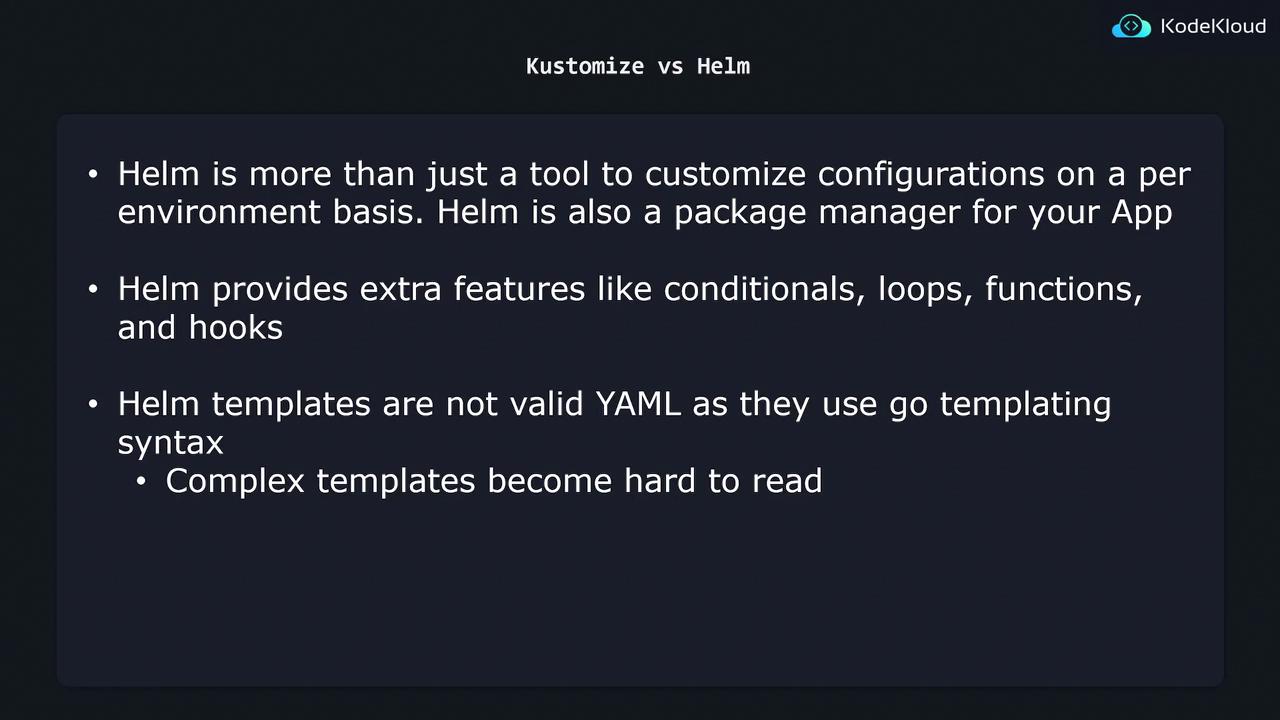Kustomize
Kustomize Overview
Kustomize vs Helm
In this article, we’ll compare Helm and Kustomize—two popular methods for managing Kubernetes manifests across different environments. Understanding their strengths, workflows, and trade-offs will help you select the best fit for your project.
How Helm Works: Go-Templating in YAML
Helm uses Go templates to inject dynamic values into your Kubernetes manifests. Placeholders in the form of {{ .Values.variable }} are replaced at deploy time based on a values.yaml file.
# templates/nginx-deployment.yaml
apiVersion: apps/v1
kind: Deployment
metadata:
name: {{ .Values.name }}
spec:
replicas: {{ .Values.replicaCount }}
selector:
matchLabels:
app: {{ .Values.name }}
template:
metadata:
labels:
app: {{ .Values.name }}
spec:
containers:
- name: {{ .Chart.Name }}
image: "nginx:{{ .Values.image.tag }}"
# values.yaml
replicaCount: 1
image:
tag: "2.4.4"
name: "my-app"
When you run helm install my-app ./chart -f values.yaml, Helm merges the values into the templates, producing valid Kubernetes YAML:
apiVersion: apps/v1
kind: Deployment
metadata:
name: my-app
spec:
replicas: 1
selector:
matchLabels:
app: my-app
template:
metadata:
labels:
app: my-app
spec:
containers:
- name: my-chart
image: "nginx:2.4.4"
Note
Use --values (or -f) to specify different environment files, e.g., -f values.prod.yaml.
Helm Chart Structure
A typical Helm chart directory might look like:
k8s/
├── environments/
│ ├── values.dev.yaml
│ ├── values.stg.yaml
│ └── values.prod.yaml
└── templates/
├── nginx-deployment.yaml
├── nginx-service.yaml
├── db-deployment.yaml
└── db-service.yaml
- templates/: Kubernetes manifests with Go templating syntax.
- environments/: Separate
values.*.yamlfiles for each environment.
Feature Comparison
| Feature | Helm | Kustomize |
|---|---|---|
| Template Syntax | Go templates ({{ }}) | Pure YAML overlays and patches |
| Conditional Logic & Loops | ✔️ Supports if, range, custom functions | ❌ Not supported |
| Packaging & Versioning | ✔️ Full-fledged chart packaging, dependencies, hooks | ❌ No built-in packaging |
| Valid YAML Before Rendering | ❌ Not valid until helm template runs | ✔️ Always valid YAML |
| Native Kubernetes Integration | ✔️ Widely adopted, independent CLI | ✔️ Built into kubectl |
Warning
Complex Helm charts with extensive logic can become hard to read and maintain. Ensure you document templates and values clearly.
Trade-offs: When to Use Each Tool
Use Helm if
• You need advanced templating (conditionals, loops, custom functions)
• You want packaging, versioning, and chart dependencies
• You require lifecycle hooks (e.g., pre-install, post-upgrade)Use Kustomize if
• You prefer pure YAML without an extra rendering step
• You want easy-to-read overlays and patches
• Your customization needs are straightforward (e.g., changing images, labels)
Balance your project’s complexity and team familiarity when choosing between the two.

References
Watch Video
Watch video content